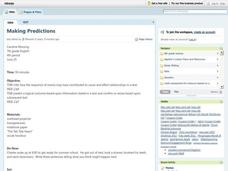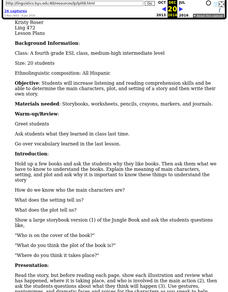Curated OER
Sequencing / Story Events
Students read a story and use sentence strips to order story events. In this sequencing instructional activity, students learn new vocabulary words centered around the story Cloudy With a Chance of Meatballs, preview the story,...
Curated OER
Sequence, Predict, Infer: Pink and Say
Practice sequencing with your 2nd graders via Patricia Polacco's Civil War book Pink and Say. Begin with a blindfold and a bag of mystery items. Connect their use of clues to identify what they can't see with the skill of making...
Curated OER
Predicting a Mystery's Solution
Practice making informed predictions. Have your class create a paper fortune-teller and ask questions about the future. They compare the fortune-telling process to the more informed kind of predictions they make while reading. They...
Teaching Oasis
Gingerbread Baby Lesson Plan Guide
Reinforce reading comprehension and story mapping skills with the help from a story, Gingerbread Baby by Jen Brett. Individuals discover new vocabulary, make predictions, retell main events, respond to reading using a graphic...
Curated OER
Changing the End of a Story
Second graders re-write a story. In this alternate endings lesson plan, 2nd graders read Alexander and the Wind-Up Mouse, by Leo Lionni, stopping to discuss the events and predict what will happen next. Students work in groups to come up...
Curated OER
Making Predictions
Seventh graders read stories, stopping periodically to make predictions. They discuss how the sequence of events, as well as cause and effect, can give hints to the outcome of the story. In addition, 7th graders use logic and...
Curated OER
Going Graph-y
Second graders listen to and dicuss the story Where the Wild Things Are. They play a pantomime game and act out various feelings so their classmates can guess. They listen for the frequency of certain words, and record their findings on...
Curated OER
Language Practice
The simple instructional techniques described in this plan will help young readers learn and practice basic reading skills and strategies. Before reading, introduce your readers to the meaning of main character, setting, and plot. Then...
Curated OER
Making Predictions
Fourth graders explore making predictions while reading. They practice making predictions about stories they will read. Students discuss predictions and some of the details of a story. They write down their predictions and compare them...
Novelinks
Where the Red Fern Grows: Graphic Organizer, Story Map
How do you grow a goal from a dream to reality? You make a plan! After reading chapters two and three of Where the Red Fern Grows, learners map how Billy earns his dogs by completing an organizer in pairs and then discussing answers in...
Curated OER
Writer's Craft: Foreshadowing
Track instances of foreshadowing in any text with a straightforward graphic organizer. In one column, learners note down the events that happened, and in the other they list the clues that indicated that those events would happen. Some...
Curated OER
If You Give a Mouse a Cookie
Students identify the cause and effect in the book If You Give a Mouse a Cookie. In this cause and effect lesson, students listen to the story If You Give a Mouse a Cookie and discuss what the cause and effect is. As a follow-up,...
Curated OER
The Chocolate Touch
Young scholars read a book. In this story elements lesson, students share their favorite food, predict what the story will be about and discuss how they would feel if they got to eat their favorite food everyday. Young...
August House
The Magic Pot
The Magic Pot by Patricia Coombs is the theme of this multidisciplinary lesson plan. Early readers first take part in a read aloud and grand conversation about the story's details. Then, they get to work practicing their skills in...
Houghton Mifflin Harcourt
We Can Do It!: Extra Support Lessons (Theme 10)
Scholars participate in chants, grand discussions, and complete practice pages in a We Can Do It! themed unit. Designed to provide extra support, the assortment of lessons cover topics such as r-controlled vowels, comparatives...
Brain Parade
See.Touch.Learn.
Here is a great app that has tons of potential in helping your child or student with severe to moderate autism, or other intellectual disability, learn words and concepts using research-based methods. Children with autism or PDD NOS have...
Curated OER
Running the Road to ABC
Second graders, while reading and discussing the book, "The Best Older Sister," by Sook Nyul Choi, practices predicting the meaning of a passage based on its title and illustrations. They experience determining the main idea from text...
Curated OER
Tomas and the Library Lady
Students practice read aloud comprehension strategies. In this literacy comprehension lesson, students listen to Tomas and the Library Lady, stopping to discuss with a partner aspects of the story suggested by the teacher. Students make...
Starfall
The Dog and His Bone
After reviewing a comic of a dog and his bone, students draw their own pictures on the top and write what they think happens next in the story. This activity is a good transition into longer story writing, as well as a good practice in...
Lesson Plansos
Guided Reading Activities with Pizzazz
Get the most out of your guided reading lessons with this collection of literacy materials. Offering a system for using color-coded tags to mark pages while reading books, as well as an assortment of comprehension and grammar...
Dr. Seuss Enterprises
Read Across America
Celebrate the whimsical world of Dr. Seuss on Read Across America Day with a collection of science, technology, engineering, the arts, and mathematics activities, each linked to a popular Dr. Seuss story.
Curated OER
Poultry in Motion (The Little Red Hen Meets Chicken Little)
Students read stories and use reading and writing skills to sequence, compare and contrast, predict, and identify parts of a story. Six lessons on one page.
Curated OER
the Little Red Riding Hood
Students respond to the story of Little Red Riding Hood. In this Red Riding Hood lesson, students retell and discuss story elements. Students practice phonic sounds. Students role play, make predictions, use picture...
PBS
Blue Ribbon Readers: Drawing Inferences
Model for young readers how to use illustrations, chapter titles, and events in a story to draw inferences and make predictions. Learners then practice these essential comprehension strategies by drawing inferences for another section of...























